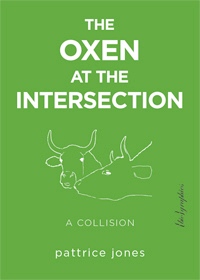Whooops! I almost forgot to blog about my new book. WHICH IS WHY WE NEED YOUR HELP TO PROMOTE IT. Since I’m bad at writing summaries and even worse at self-promotion, let me just quote how the publisher describes the book on its back cover:
When Green Mountain College in Poultney, Vermont, announced that two oxen called Bill and Lou would be killed and turned into hamburgers despite their years of service as unofficial college and town mascots, pattrice jones and her colleagues at nearby VINE Sanctuary offered an alternative scenario: to allow the elderly bovines to retire to the sanctuary. What transpired after this simple offer was a catastrophe of miscommunication, misdirection, and misinterpretations, as the college dug in its heels, activists piled on, and social media erupted.
Part true-crime mystery, part on-the-ground reportage, and part sociocultural critique, The Oxen at the Intersection is a brilliant unearthing of the assumptions, preconceptions, and biases that led all concerned with the lives and deaths of these two animals to fail to achieve their ends. How and why the threads of this story unspooled, as jones reveals, raises profound questions—most particularly about how ideas rooted in history, race, gender, region, and speciesism intersect and complicate strategy and activism, and their desired outcomes. In the end, notes jones, we must always ask, Where’s the body?
The book is divided into two parts (“What Happened” and “What Happened?), the former of which tells the tale of the calamity that was the campaign to “Save Bill and Lou,” and the latter of which looks at three aspects of the story (“The Power of Place,” “Dangerous Intersections,” and “Animal Psychology”), each of which had multiple features and all of which were active simultaneously as the drama unfolded.
 I believe that both GMC and Bill and Lou’s far-flung advocates will be surprised to see what the controversy looked like from my standpoint here at VINE. Nonetheless, I hope that people will read that part of the book quickly. The heart of the book is the analysis that follows the recitation of events. There, I try to show how multiple factors converged to “overdetermine” GMC’s steadfast determination to kill, rather than retire, two elderly oxen many campus community members professed to love, despite (or perhaps because of) literally worldwide cries for mercy. Some of those factors may surprise you, no matter who you might be or where you stood on the controversy.
I believe that both GMC and Bill and Lou’s far-flung advocates will be surprised to see what the controversy looked like from my standpoint here at VINE. Nonetheless, I hope that people will read that part of the book quickly. The heart of the book is the analysis that follows the recitation of events. There, I try to show how multiple factors converged to “overdetermine” GMC’s steadfast determination to kill, rather than retire, two elderly oxen many campus community members professed to love, despite (or perhaps because of) literally worldwide cries for mercy. Some of those factors may surprise you, no matter who you might be or where you stood on the controversy.
Speaking of which, I do hope that both proponents and opponents of the slaughter of Bill and Lou will read this book, which is intended to help everybody become more mindful of the myriad material, cultural, and emotional factors that combine to shape our thoughts and behavior in relation to nonhuman animals. And, while I do hope that the book will provoke animal advocates to think much more complexly, activists in other movements also may find my method of thinking through this “case study” in activism to be useful to their own efforts.
Oh! and the author’s portions of the proceeds of the sale of this book (which is available in both Kindle and paperback editions) will be paid directly to VINE. So, please do think about buying copies for friends or for your local library. If you like the book, please do use social media to tell your friends and comrades about it. Thanks!




I read it cover to cover in about 24 hours and could not put it down. From the acknowledgment and history of whose land we stand on to the psychological analysis of social behavior that led to the harm and death in this story… I was gripped and excited and mourned and was even left feeling hopeful for a future in which better outcomes are possible some day.
The first half’s story was riveting. I remember this all going down but I had no idea about all of these details and got so much out of reading and watching this story take place in my mind. It made me recall big things I was part of and the stress and struggle and inter/extrapersonal communications and conflicts that occurred. It was validating in some ways to see that others have experienced these chaotic experiences where everything is not black and white, and in some ways, it is.
The second half is just… everything. It’s everything. So many things I think and feel and have written and spoken of. So many criticisms I have had within our movements and outside of them. So many goals I have had for myself- to see the gray areas, to avoid harmful group dynamics, to remember where I came from, and to remember others come from somewhere, too. The what-we-learned section, the growth there… I wish we did that more. The tactics analysis, that different tactics exist for different things… I wish we did that more.
I will be thinking about this book and passing it on for a long time.
Thank you endlessly for writing it.